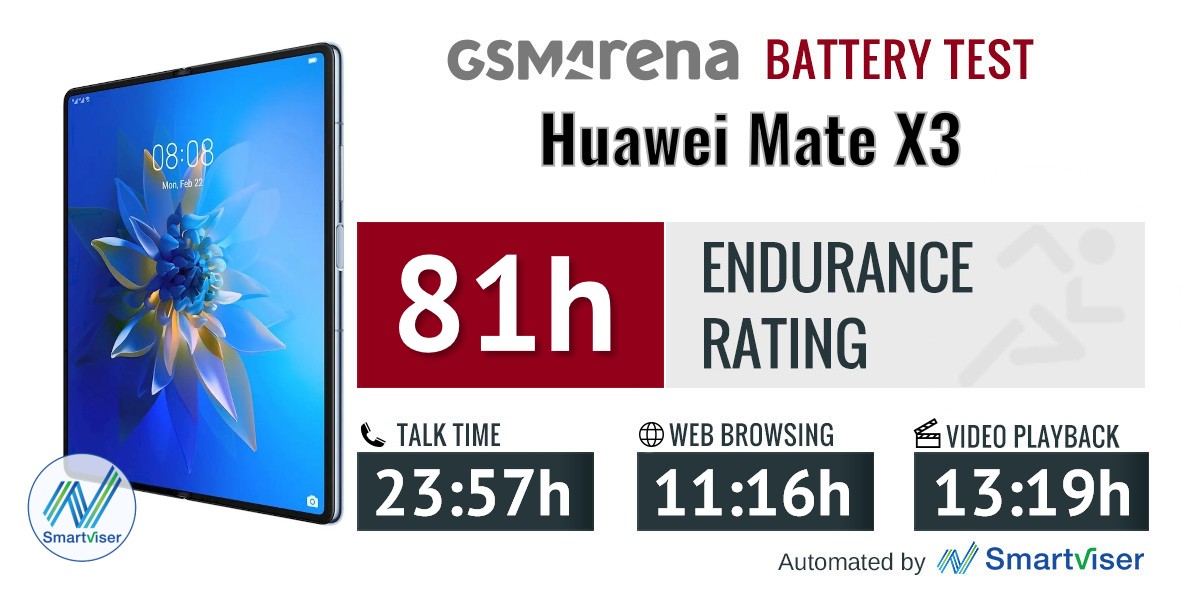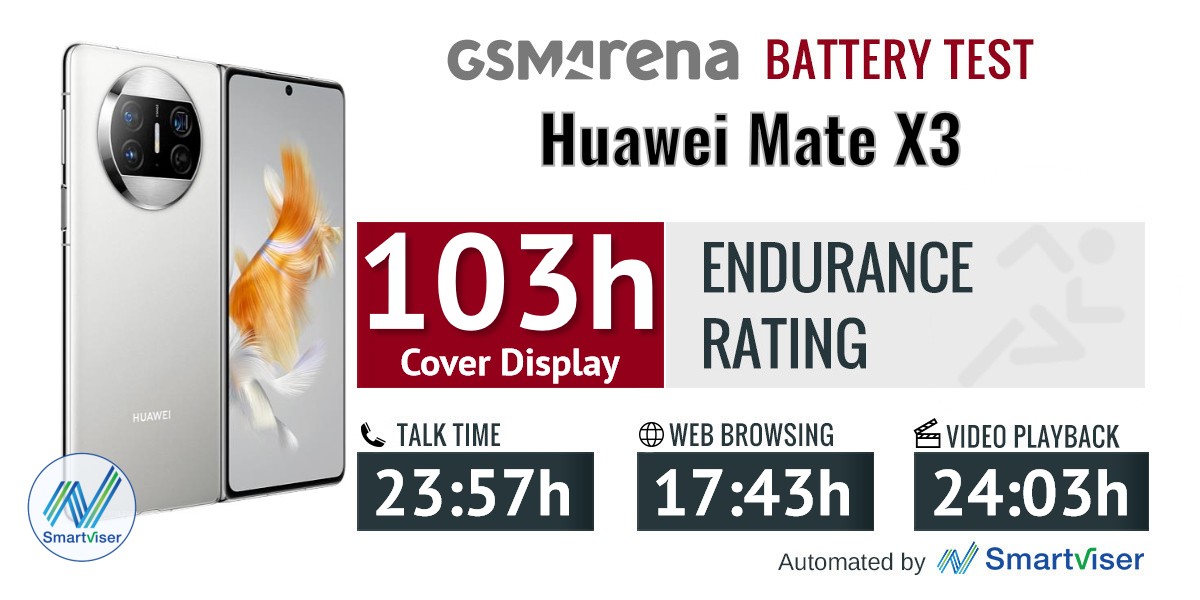Huawei Mate X3 review

A pair of 120Hz displays
The Mate X3 has a pair of bright, vibrant and fast OLED panels at its disposal. Both of these have gotten a bit smaller coming from the previous generation Mate X2 but are still bigger than what Samsung offers on the Galaxy Z Fold4. The main inside display on the Mate X3 has a 7.85-inch diagonal and a resolution of 2224 x 2496 pixels, which works out to about 426 ppi - sharper than both the Mate X2 and the Z Fold4.

The cover display measures 6.4 inches in diagonal with a resolution of 1080 x 2504 pixels. These displays have relatively small punch-hole cameras and share the same 120Hz refresh rate. This is up from the 90Hz refresh rate on both of the displays of the Mate X2.

The inside display on the Mate X3 is pretty bright, especially considering its large size. We measured 468 nits on the slider with a maximum automatic brightness of 926 nits under bright sunlight. The Mate X3 is perfectly usable outdoors. It appears to have a couple of light sensors - one for the main inside display and another one for the cover display, which is great to see.
Speaking of the cover display, it offers great performance as well, with 476 nits on the slider and 1164 nits of maximum brightness. Neither of the two displays is particularly reflective, making outdoor use even easier.

It is interesting to note that the two displays share one set of brightness and color settings within the phone's menu. Huawei did a surprisingly good job matching the brightness output of the two panels at the same brightness setting, which is great to see.
The Mate X3 only has a couple of color modes in its display settings menu. Both the normal and vivid modes target the DCI-P3 color space and do a reasonably good job of it.
Neither is particularly color-accurate, though, on either the inside or the cover display. The Mate X3 boosts the green and cyan colors for some reason. Not annoyingly so, but still enough not to be considered "color-accurate".

The main inside display of the Mate X3 is actually 10-bit, which is a great little addition. However, there is no official HDR support, which is an unfortunate omission. On a software level, the Mate X3 supports HDR10, HDR10+ and HLG decoding, with just Dolby Vision missing from the list. The phone also has the highest possible L1 Widevine DRM certification, allowing apps like Netflix to offer up FullHD streams.



HDR decoder • Widevine • Netflix playback capabilities
High refresh rate handling
As already mentioned, the main and cover displays on the Mate X3 have a native 120Hz refresh rate. On a software level, the phone offers a trio of refresh rate modes to choose from. These settings, just like brightness and colors, are shared between the two displays.
First, let's start with the cover display, which seems to have the simplest behavior. In standard mode, this display operates at a locked 60Hz. No surprises there. Dynamic mode engages 120Hz for as long as you interact with the phone. Leave it alone for a few seconds, and the refresh rate drops to 60Hz.
There seems to be no extra logic related to the type of content being displayed on screen and whether it has motion in it. In fact, the High refresh rate mode operates exactly the same as Dynamic mode on the cover display. The core logic is unchanged - 120Hz while interacting with the display and 60Hz otherwise.
The Dynamic refresh rate mode makes more of a difference on the main display of the Mate X3, where it tends to favor 90Hz refresh rate mode and stick to that most of the time. Certain screens do up said refresh rate to 120Hz, but the display usually sticks to 90Hz.
In contrast, the High refresh rate mode tends to favor 120Hz on the main display. That seems to be the main difference between the two. The display also doesn't drop down to 60Hz on its own without interaction in high refresh rate mode. Once again, there is no smart behavior related to the content that is being displayed on screen.
We did try high refresh rate gaming with a few titles we know can push past the 60fps mark. We found that the High mode more consistently ran games at a higher refresh rate than the Dynamic mode, which is good to note. The games ran at either 120Hz or 90Hz, which is a generally positive result.




High refresh rate gaming on the Mate X3
All things considered, the Mate X3 handles its high refresh rate in a pretty simple way, which isn't particularly straightforward either. There is some dynamic switching, but it is inconsistent and hard to follow. We would love to see some extra effort on this front.
Battery life
The Mate X3 packs a rather large 4,800 mAh battery. The Chinese version of the phone has a silicon-carbon pack with a typical capacity of a whopping 5,060 mAh. That is reserved for the Chinese model, though. The review unit we tested has a 4,800 mAh battery. We made sure to test both the main inside display and the cover display on the Mate X3.
The main display on the Mate X3 is pretty power-hungry but still does decently well in on-screen tests. The Mate X3 does well with off-screen tests, though we've seen the Snapdragon 8+ Gen 1 do better in calls and standby.

It is worth noting that the web browsing tests on the Mate X3 were done at the maximum 120Hz refresh rate of each of the displays, whereas the video playback ones were done at 60Hz.
The cover display on the Mate X3 does a lot better with battery endurance than the inside one. You can get into triple-digit endurance rating by using the outside cover display on the phone.

Our battery tests were automated thanks to SmartViser, using its viSerDevice app. The endurance rating denotes how long the battery charge will last you if you use the device for an hour of telephony, web browsing, and video playback daily. More details can be found here.
Video test carried out in 60Hz refresh rate mode. Web browsing test done at the display's highest refresh rate whenever possible. Refer to the respective reviews for specifics. To adjust the endurance rating formula to match your own usage patterns check out our all-time battery test results chart where you can also find all phones we've tested.
Charging
The Mate X3 supports 66W SuperCharge. That's far from the fastest charging Huawei offers, but it is still quite competitive in the modern landscape. Unfortunately, the 66W charger still uses a proprietary USB Type-A to Type-C 6A-capable cable, which you need to keep track of alongside the proprietary charger. The 66W Huawei charger is rated for an output of 5V@2A, 10V@4A and 11V@6A.

The Mate X3 is far from the fastest-charging device out there, but it still holds its own well.
Speakers
The Mate X3 has a pair of stereo speakers at its disposal. These are pretty thin, given the very limited space Huawei has to work with.
Even so, the speakers sound great and have a surprisingly good frequency response.
At -26.3 LUFS, the speakers get plenty loud as well. Even at full blast, the sound remains clear with minimal distortion.
There isn't anything fancy in the way of software improvements and equalizers on the Mate X3. In fact, we failed to even find a basic equalizer. Huawei Histen sound effects are just for headphones and not the speakers. Still, with a rich sound stage like this, we can't say we miss eq settings all that much.
Use the Playback controls to listen to the phone sample recordings (best use headphones). We measure the average loudness of the speakers in LUFS. A lower absolute value means a louder sound. A look at the frequency response chart will tell you how far off the ideal "0db" flat line is the reproduction of the bass, treble, and mid frequencies. You can add more phones to compare how they differ. The scores and ratings are not comparable with our older loudspeaker test. Learn more about how we test here.
Reader comments
- captain fokou
- 27 Aug 2023
- 0TK
How can the some of the cons be : The free fast charger in the box does support pd when they say nothing about the z fold 5 not having one at all. They don't like the nm card and yet they say nothing about the z fold 5 not having expendable ...
























